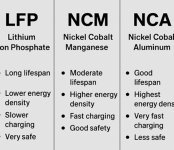LFP vs. NCM vs. NCA Batteries: What’s the Real Difference and Which One Is Better?
Electric vehicle buyers today often hear these three mysterious acronyms — LFP, NCM, and NCA — when reading spec sheets or comparing EVs.
Tesla, BYD, Volvo, and BMW all use different types of batteries, and each claims their technology is “the best.”
But what’s really behind these letters?
Let’s break it down simply and see which chemistry lasts longer, charges faster, and stays safer — without marketing jargon.
1. What Do These Battery Types Mean?
Each name refers to the chemical composition of the cathode, one of the key parts of a lithium-ion battery.
| Type | Full Name | Main Elements | Common Users |
|---|---|---|---|
| LFP | Lithium Iron Phosphate | Lithium (Li), Iron (Fe), Phosphate (PO₄) | BYD, Tesla (China models), some Volvos |
| NCM | Nickel Cobalt Manganese | Lithium, Nickel, Cobalt, Manganese | BMW, Hyundai, Kia, Volvo |
| NCA | Nickel Cobalt Aluminum | Lithium, Nickel, Cobalt, Aluminum | Tesla (U.S. models), Panasonic |
So, when we say an EV has an LFP or NCM battery, we’re talking about different chemistries that affect performance, cost, and safety.
2. The Core Differences
LFP (Lithium Iron Phosphate)
- Durability: Excellent — can handle 3,000–5,000 charge cycles (very long lifespan).
- Safety: The safest of all three; resistant to overheating or fire.
- Energy Density: Lower — holds less energy per kilogram, meaning slightly shorter range.
- Cost: Cheapest to make (no nickel or cobalt).
- Charging Speed: Moderate — charges slower than NCA/NCM at low temperatures.
- Temperature Sensitivity: Struggles in cold climates; performance drops below 0 °C.
LFP = long-lasting, safe, but less energy-dense and slower to charge.
NCM (Nickel Cobalt Manganese)
- Durability: Moderate — around 1,500–2,000 charge cycles.
- Safety: Good, but can overheat under stress; requires advanced cooling systems.
- Energy Density: High — provides more range per kg than LFP.
- Cost: More expensive (nickel and cobalt are costly and volatile).
- Charging Speed: Fast, especially with high-power chargers.
- Temperature Sensitivity: Performs well in cold; more stable range than LFP.
NCM = balanced chemistry for performance, range, and charging speed.
NCA (Nickel Cobalt Aluminum)
- Durability: Good — typically 2,000–3,000 cycles, though sensitive to stress.
- Safety: Requires strict thermal control; can degrade faster at high temps.
- Energy Density: Highest — ideal for long-range EVs like Tesla’s Model S.
- Cost: Similar to or higher than NCM due to complex manufacturing.
- Charging Speed: Very fast when properly cooled.
- Temperature Sensitivity: Works well in cold; heat accelerates wear.
NCA = maximum range and power, but needs careful management.
3. Which One Lasts Longer?
| Chemistry | Typical Lifespan | Real-World Notes |
|---|---|---|
| LFP | 10–15 years | Maintains >80% capacity even after 3000+ cycles. |
| NCM | 7–10 years | Good lifespan but depends on heat management. |
| NCA | 8–12 years | Excellent lifespan if not overheated frequently. |
So LFP batteries usually last the longest in years — even if their range is shorter.
4. Which Charges Faster?
- NCA and NCM batteries can charge from 10–80% in about 20–30 minutes on high-power DC chargers.
- LFP typically needs 30–45 minutes for the same range increase.
However, in daily use, most drivers won’t notice much difference unless they fast-charge often.
The biggest gap appears in cold weather, where LFP batteries charge much slower until warmed up.
5. Which Is Safer?
This is where LFP clearly wins.
- LFP’s chemical stability makes it much less likely to catch fire or enter “thermal runaway.”
- Even if punctured, LFP cells tend to heat slowly and self-extinguish.
- NCA and NCM packs require active cooling, monitoring, and protective software to stay safe.
It’s one reason BYD’s “Blade Battery” (LFP) is gaining popularity — it passed nail penetration and fire tests with minimal damage.
6. Cost Comparison
| Type | Approx. Cost (per kWh) | Example Use |
|---|---|---|
| LFP | ~$80–90 | BYD, Tesla Model 3 RWD (China) |
| NCM | ~$100–120 | BMW i4, Kia EV6, Volvo EX30 |
| NCA | ~$110–130 | Tesla Model S/X, Lucid Air |
NCM and NCA are more expensive but deliver better range and performance.
7. Performance in Different Climates
| Climate | Best Battery Type | Why |
|---|---|---|
| Cold regions (Canada, Scandinavia) | NCM / NCA | Better cold efficiency |
| Hot climates (California, Southern Europe) | LFP | Safer, less thermal stress |
| Mild climates (UK, Central Europe) | Any | All work well, minor differences |
8. Which One Fits Which Driver?
| Driver Type | Recommended Battery | Reason |
|---|---|---|
| Daily city driver | LFP | Safe, cheap, long life, moderate range fine |
| Long-distance commuter | NCA | Fast charging, high range |
| Performance enthusiast | NCM / NCA | High power output |
| Fleet / taxi / delivery | LFP | Long cycle life, low degradation |
9. Why Do Manufacturers Use Different Batteries?
Each automaker picks chemistry based on priorities:
- Tesla uses both: LFP for cheaper models, NCA for performance ones.
- BYD uses only LFP (Blade Battery) for safety and cost.
- BMW / Volvo / Hyundai rely mainly on NCM for range and balanced performance.
It’s not about one being “better,” but about matching chemistry to the car’s purpose.
10. The Future of Battery Chemistry
New versions are already emerging:
- LMFP (Lithium Manganese Iron Phosphate) – an LFP upgrade with better energy density.
- Solid-State Batteries – next-generation tech promising even higher safety and range (expected later this decade).
Still, for 2025–2030, LFP, NCM, and NCA will dominate — each serving its niche.
Summary Table
| Feature | LFP | NCM | NCA |
|---|---|---|---|
| Lifespan | |||
| Safety | |||
| Energy Density | |||
| Cost | |||
| Fast Charging | |||
| Cold Performance | |||
| Ideal User | City / Fleet | Balanced driver | Long-range / Performance |

Final Thoughts
So — which one’s best?
- If you want maximum safety and longevity → go for LFP.
- If you want range and flexibility → choose NCM.
- If you need ultimate performance and power → NCA is still king.
The truth is, there’s no single “best” battery — just the one that best fits your lifestyle, climate, and driving habits.
As the EV industry matures, these chemistries will keep improving, but understanding the basics of LFP, NCM, and NCA helps every buyer make smarter, safer, and more confident decisions on their next electric car.
